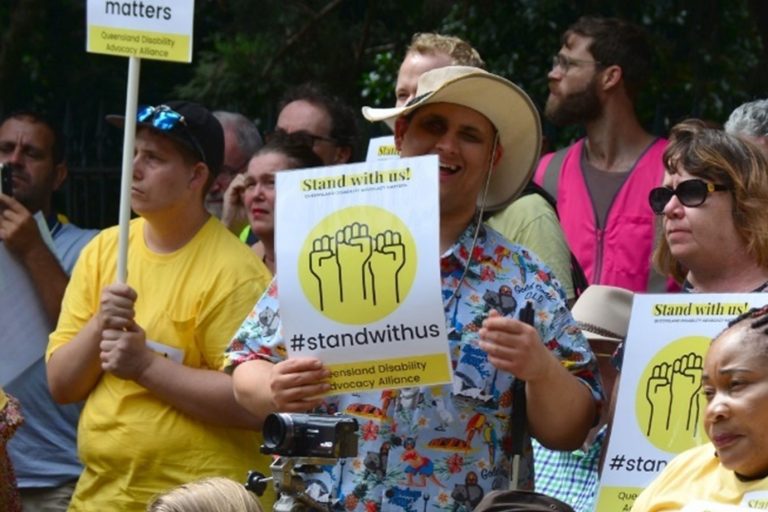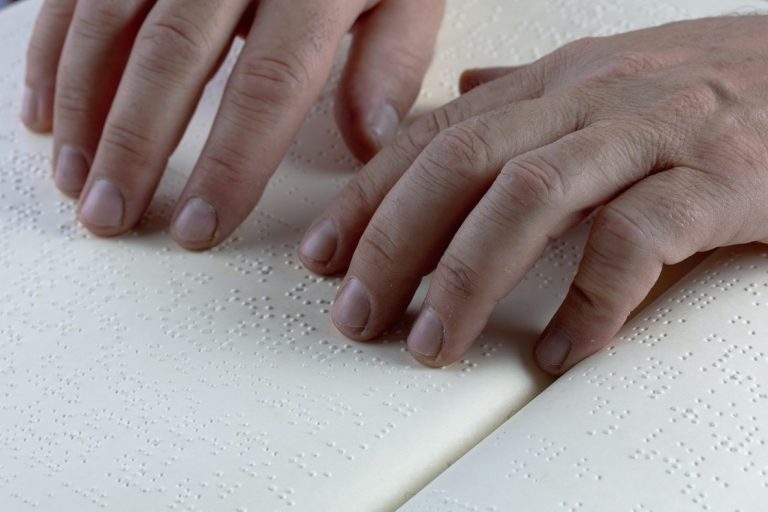Nothing about us without us: Talking accessibility this World Braille Day

Caption: Brendon Donohue at the Brisbane ‘Stand with us!’ rally in March 2021
Have you ever noticed little raised dots at traffic lights, on ATMs, or elevator buttons, and wondered what they are? Small but mighty, these little bumps are known as Braille, a complex language that some people who are blind or have low vision use in their daily lives. Braille is a tactile language (tactical means being able to touch), people read by running their fingertips over combinations of dots.
Braille is made up of six raised dots that represent letters, numbers, punctuation signs, groups of letters, entire words, as well as musical, mathematical and scientific symbols. People use Braille for a variety of reasons, like labelling household items, reading phone numbers, writing grocery lists, and reading books. Refreshable braille displays enable people to read emails, e-books and other online documents.

Caption: People read Braille by running their fingertips over combinations of raised dots.
Today, January 4, marks World Braille Day, the birthday of Louis Braille, creator of Braille. Louis was a French educator and musician who after an accident as a child, became blind in both eyes. In 1824 when he was only 15 years old, Louis created the first version of Braille, based on a system that relied upon writing using dots, invented several years earlier by Charles Barbier for military communication.
The reason we celebrate World Braille Day is to raise awareness of the importance of Braille as a means of communication for people who are blind or have low vision. It is crucial that information is produced in accessible formats like Braille, so people who are blind or have low vision have equal access to education, freedom of expression and opinion, as well as social inclusion.
Even though Braille was created hundreds of years ago, it is still important today for people who are blind or have low vision, including QDN member Brendon Donohue. Brendon is blind and says Braille is critical in the lives of people who are blind or have low vision.
“For people who are blind or have low vision, Braille gives you access to information -information is power,” says Brendon.
“To be involved in the community, we need access to information and technology.”
“Braille is critical in education and employment, the research tells us that people who read and write with Braille have higher employment rates and education completion*.”
Brendon says there are barriers to people who are blind or have low vision learning and using Braille, something he is passionate and vocal about changing.
“Some people aren’t given the opportunity to learn Braille, or learn it when they’re young, the technology isn’t accessible because financially it’s really challenging, especially if you’re not eligible for the NDIS,” says Brendon.
Brendon says it’s critical people who are blind or have low vision are included in decision-making about Braille accessibility.
“One of the things we need to do is actually consult with people who have experience reading and writing with Braille,” Brendon says.
“Consultation is the key. ‘Nothing about us without us’ - for that to really be the case, we need to include the people who are using Braille.”
According to Brendon, one important factor to consider is where Braille is located.
“It’s great that Braille is used in the community, but it needs to be installed consistently, sometimes it can be really difficult to find where Braille is,”
“A number of years ago, legislation was introduced dictating that Braille needed to be installed on signage and for signage to be installed in consistent locations, but it’s taking a really long time for this to happen”.
Brendon learnt Braille when he was in year one at school but says a lot has changed since then.
“The books I used to learn Braille from were old, the pages were yellow with age and the dots were worn down. It was really challenging and it took me three years to learn Braille when it should have only taken me one.”
“Braille is a lot easier to use with the introduction of newer technologies today.”
For someone who is learning Braille, or is considering learning, Brendon says not to try and learn it all at once.
“Start very small, learn the alphabet and the numbers first. Don’t think you can learn it in five minutes.”
For more information about Braille in Australia, visit the Australian Braille Authority’s website at https://brailleaustralia.org/.
* Ryles, R. (1996). The Impact of Braille Reading Skills on Employment, Income, Education, and Reading Habits. Journal of Visual Impairment & Blindness, 90(3), 219–226. https://doi.org/10.1177/0145482X9609000311
